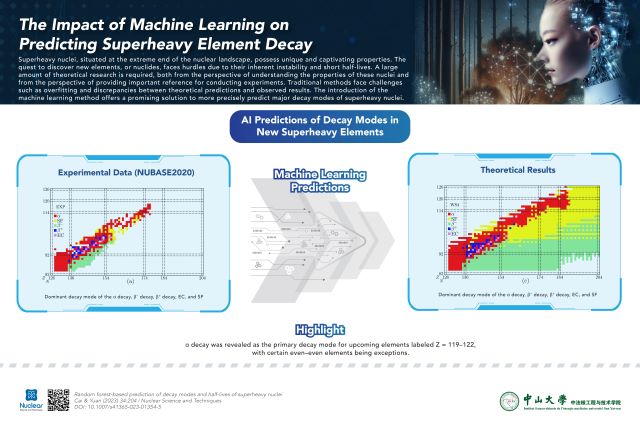博文
[转载]机器学习对预测超重元素衰变的影响
||
中山大学中法核工程与技术学院核数据科学与应用学科团队成果
Article title: Random forest-based prediction of decay modes and half-lives of superheavy nuclei
文章标题:利用随机森林预测超重核衰变模式和半衰期
DOI: 10.1007/s41365-023-01354-5

One sentence summary:
一句话概要:
Utilizing a machine learning method, this study advances the prediction of decay modes in superheavy nuclei, offering profound insights into the elusive realm of atomic elements beyond uranium.
利用机器学习方法,这项研究推进了对超重核衰变模式的预测,为超铀元素的神秘领域提供了深刻的洞察。
Keywords:
关键词:
Decay Mode, Superheavy Nuclide, Random Forest
衰变模式、超重核素、随机森林
The Novelty (What)
创新性(主要内容)
Utilizing a computational model, the research introduces the application of a random forest (RF) algorithm which successfully predicted the decay modes of superheavy nuclei. This method accurately determined the dominant decay mode for an impressive 96.9% of nuclei beyond 212Po. Furthermore, the study revealed α decay as the primary decay mode for upcoming elements labeled Z = 119–122, with certain even–even elements being exceptions. This novel approach not only provides a refined predictive tool for nuclear decay but also paves the way for more profound explorations within the realm of superheavy elements in the future.
利用计算模型,这研究引入了随机森林算法的应用,成功预测了超重核的衰变模式。这种方法准确地确定了212Po之后96.9%超重核的主要衰变模式。此外,研究揭示了α衰变是标记为Z = 119–122的未来元素的主要衰变模式,但某些偶偶核素是例外。这种新颖的方法不仅为核衰变提供了一个精确的预测工具,而且为未来超重元素领域的更深入探索铺平了道路。
The Background (Why)
研究背景(主要原因)
Superheavy nuclei, situated at the extreme end of the nuclear landscape, possess unique and captivating properties. The quest to discover new elements, or nuclides, faces hurdles due to their inherent instability and short half-lives. Currently, the experimental equipment is still far away from exploring all these nuclei. A large amount of theoretical research is required, both from the perspective of understanding the properties of these nuclei and from the perspective of providing important reference for conducting experiments. Traditional methods, both microscopic and macroscopic, have been employed to study nuclear binding energy and decay half-lives. However, these methods face challenges such as overfitting and discrepancies between theoretical predictions and observed results. The introduction of the machine learning method aims to bridge these knowledge gaps, offering a promising solution to more precisely predict major decay modes of superheavy nuclei. This approach aspires to shed light on the intricate interplay between α decay, β decay, and spontaneous fission in newly identified elements, potentially revolutionizing our understanding in this field.
超重核位于核素图的极重边界,拥有独特的性质。由于固有的不稳定性和极短半衰期,寻找新元素和新核素面临着巨大阻碍。目前,实验设备仍远远无法探索所有这些核素。该领域的探索需要大量理论研究,既要理解这些核素的特性,也要为进行实验提供重要参考。传统方法,无论是微观还是宏观方法,都被用来研究核结合能和衰变半衰期。然而,这些方法面临着如过度拟合、理论预测与实验观测结果之间的差异等挑战。引入机器学习方法旨在弥合这些知识差距,提供更精确地预测超重核主要衰变模式的有希望的解决方案。这种方法希望阐明新识别元素中α衰变、β衰变和自发裂变之间复杂的相互影响,革新我们在这个领域的理解。
The SDG impact (Big Why)
SDG影响力(研究意义)
At the frontier of natural science, the quest to answer how many elements can exist and whether stable or long-lived nuclides exist above uranium is more than an academic pursuit; it's a journey to the heart of matter itself. This profound question underlines the urgency of exploring the "islands of stability," a concept that could redefine our understanding of the periodic table and material science. The research directly contributes to Sustainable Development Goal 9 (Industry, Innovation, and Infrastructure) by driving progress in scientific research and innovation, which are crucial for building resilient infrastructure and fostering inclusive and sustainable industrialization.
在自然科学的前沿,探寻有多少元素存在以及铀以上是否存在稳定或长寿命核素的问题不仅是学术追求,更是探索物质本质的旅程。这个深刻的问题强调了探索“稳定岛”的紧迫性,这个概念可能重新定义我们对元素周期表和材料科学的理解。这项研究直接促进了可持续发展目标9(产业、创新和基础设施),推动科学研究和创新的进步,这对于建设有韧性的基础设施和促进包容和可持续的工业化至关重要。
https://blog.sciencenet.cn/blog-3474219-1420096.html
上一篇:[转载]利用先进的机器学习模型破解核反应堆物理学之谜
下一篇:[转载]无损中子技术促进材料研究与保护的发展